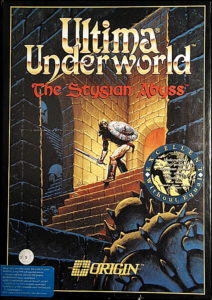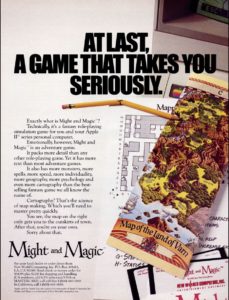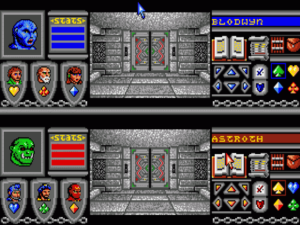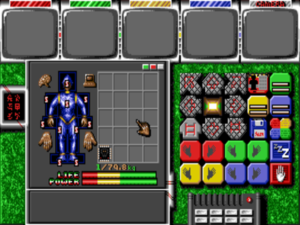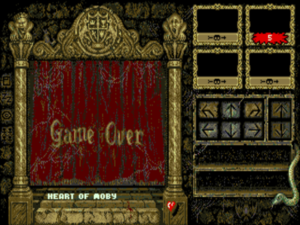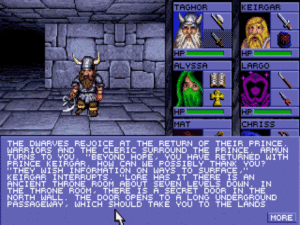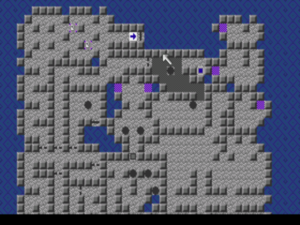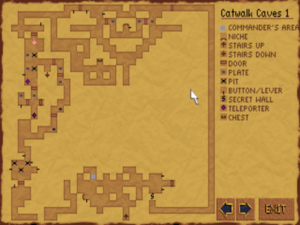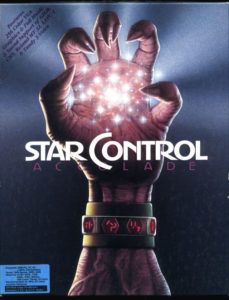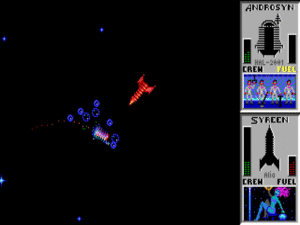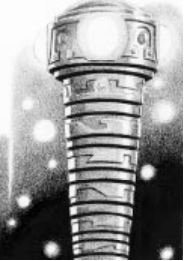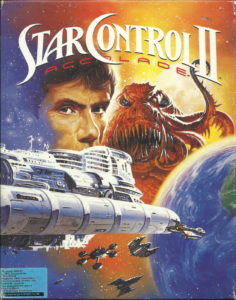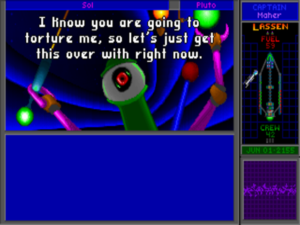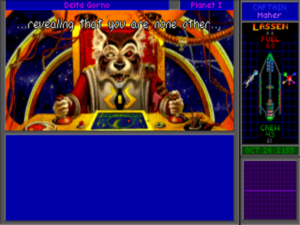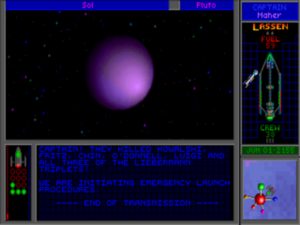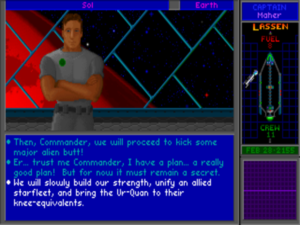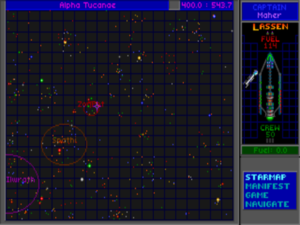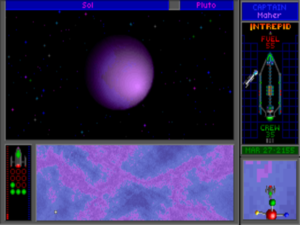The 1980s was the era of the specialist in game development, when many of the most successful studios did just one or two things, but did them very, very well. For Infocom, that meant text adventures; for Sierra, graphic adventures; for MicroProse, military simulations; for SSI, strategic wargames and Dungeons & Dragons; for Epyx, joystick-twiddling sports and action games; for Origin, Ultima. When such specialists stepped outside of their comfort zones, the results were occasionally a triumph, but more often merely served to reemphasize their core competencies.
The most respected studios of the 1990s, however, tended toward more eclecticism. Developers like Dynamix and Westwood may have had their roots in the previous decade, but they really came into their own in this one, and did so with games of very diverse types. Westwood, for example, was happily making CRPGs, graphic adventures, real-time-strategy games, and Monopoly, for Pete’s sake, all virtually at the same time. Even the holdover specialists from the 1980s — those who were still standing — aggressively tried to diversify in the 1990s: Sierra moved into strategy games, MicroProse into CRPGs and graphic adventures, Origin into Wing Commander.
Still, if we look harder at many 1990s developers, we can find themes that bind together their output. In the case of Dynamix, we might posit that to be an interest in dynamic simulation, even when working in traditionally static genres like the graphic adventure. In that of Westwood, we can identify an even more pronounced interest in bringing the excitement of real time to traditionally turn-based genres like the CRPG and the wargame. And in the case of the studio we’ll be meeting for the first time today — Looking Glass Technologies, arguably the most respected and beloved 1990s studio of all — the binding thread is crystal clear. From beginning to end, they used the flexibility of 3D graphics to bring virtual environments to life in unprecedentedly immersive ways. Whether making a CRPG or a flight simulator, a first-person shooter or a first-person sneaker, this was their constant.
3D graphics were, one might say, baked right into Looking Glass’s DNA. Paul Neurath and Ned Lerner, its two eventual founders, met one another in 1978 in a computer-science course at Wesleyan University, where Neurath was studying environmental science, Lerner physics. For the course’s final project, they teamed up to make a 3D space game rendered in ASCII text. They got a B-minus on it only because their professor considered games to be beneath his course’s dignity.
After university, the two New England boys remained friends as they started their professional careers. When the home-computer craze got rolling in earnest, each bought an Apple II. They started experimenting, together and apart, on games much like the one they had written for that computer-science class, only implemented in real bitmap graphics, with a real joystick as a controller. These efforts culminated in a joint game known as Deep Space: Operation Copernicus, which they sold in 1985 to the publisher Sir-Tech, purveyors of the Wizardry CRPG series. Sir-Tech didn’t seem to know quite what to do with Neurath and Lerner’s very different sort of game, and it never escaped Wizardry‘s long shadow. Nevertheless, the experience of making a game and getting paid for it — however modestly — lit a fire in both partners. Each went off to pursue his own agenda, but they remained in touch, keeping one another updated on their progress and often sharing code and technical tricks.
Initially, it was Ned Lerner who made the most determined effort to become a real commercial game developer. He formed a little company called Lerner Research, and started gathering like-minded souls around him. As fixated as ever on 3D graphics, he decided that an at least semi-realistic flight simulator would be a good application for the technology. The leading product of that type on the market, subLOGIC’s generically titled Flight Simulator, he considered akin to a “textbook lesson”; he envisioned a flight simulator of his own that would be more accessible and fun. He hired an aerodynamic engineer to design a flight model for his game, which would focus on high-performance military aircraft like the legendary SR-71 Blackbird rather than the little Cessna that was forever tooling around from airport to airport in subLOGIC’s simulator. In fact, his game would let you fly any of fourteen different airplanes, in contrast to its rival’s one, and would concentrate on goal-oriented activities — “Flight Instruction,” “Test Flight,” “Formation Flying,” or “Airplane Racing” — instead of just expecting you to choose a starting airport and do whatever tickled your fancy.
Electronic Arts, who lacked a competitive flight simulator and were eager to get in on one of the industry’s fastest-growing segments, signed on as publisher. Unlike Sir-Tech, they knew the appeal of snazzy packaging and celebrity endorsements. They convinced Chuck Yeager to put his name on the product. This was quite the coup; Yeager, a World War II fighter ace and the first man to break the sound barrier, was by far the most famous pilot in the country, after having been brought to indelible life by the actor Sam Shepard in the recent hit movie The Right Stuff. It was a decidedly nervous group of nerds and businessmen who met this aerospace legend for the first time in March of 1987. Lerner:
As we were sitting there in the office, listening to the rain outside, Rich Hilleman, associate producer at EA, was first to spot the Blazer entering the parking lot (license plate “BELL X1”). A few minutes later, we heard the unmistakable West Virginia drawl outside the door, as pure and easygoing as the man on TV who sells spark plugs with a shotgun. For a brief second, I remembered the opening scene of Patton where George C. Scott steps forward, dressed to the teeth in full military regalia. The door suddenly opened, and there he was: wearing cowboy boots, blue jeans, and a polo shirt under his racing-style jacket. General Yeager had a trim figure, and his face was tan, well-weathered, as if he had spent a lot of time outdoors. The general stepped forward, shaking hands with the members of the group, but I sensed a certain degree of reservation in his actions.
To get past this awkward beginning, we loaded in the current version of Advanced Flight Trainer. I flew the simulator for a while, then offered to let General Yeager take over. “I never fooled with these things,” he said. “That’s because, you know, the damned things are so…” — he searched for the word — “…insignificant. If you want to really scorch something, hell, you can program the X-31 in there, the aerospace plane. Now, see, you got some kid who can say, ‘Man, this thing is smoking along at mach 25.'”
The ice had finally been broken, and we all began contributing to the conversation. After discussing the subjects of liquid-oxygen fuel and the current type of aircraft that are touching the edge of space, the day was practically over. “This thing’s pretty dang realistic,” he told us. “You’ve got a lot of goodies in there.”
Released about six months later with much publicity, Chuck Yeager’s Advanced Flight Trainer became by far EA’s biggest hit of the year, and one of their biggest of the whole decade. With that push to get them off and running, Lerner Research continued their work on the frontiers of 3D graphics, giving EA a substantially revised version 2.0 of their flagship game in 1989.
Even as Ned Lerner was hobnobbing with famous test pilots, Paul Neurath was making his own inroads with the games industry. Shortly after finishing Deep Space, he had heard that Origin Systems of Ultima fame was located in New Hampshire, not all that far from him at all. On a lark, he drove down one day to introduce himself and take the temperature of the place. He hit it off immediately with Richard Garriott and the rest of the crew there. While he never became a full-fledged employee, he did become a regular around the Origin offices, contributing play-testing, design ideas, and occasional bits of code to their games on a contract basis.
In early 1987, Richard Garriott, who loathed New England with every fiber of his being, packed up and moved back to Austin, Texas, with most of Origin’s technical and creative staff. He left behind his older brother and business manager Robert, along with the latter’s support staff of accountants, secretaries, and marketers. A few developers who for one reason or another didn’t want to make the move also stayed behind. Neurath was among this group.
At about this same time, Neurath got the green light to make a game all his own for Origin. Space Rogue began as another 3D space shooter — another Deep Space, enhanced with some of the latest graphics technology from his friends at Lerner Research. To this template Neurath grafted a trading economy, a customizable spaceship, and a real plot. The player was even able to exit her spaceship and wander around the space stations she visited, talking to others and taking on quests. There was a surprising amount of ambition in this fusion of Deep Space, Elite, and Ultima, especially considering that Neurath designed, wrote, and programmed it all almost single-handedly from New Hampshire while most of his friends at Origin pursued other projects down in Austin. Although its disparate parts don’t ever gel quite well enough to make it a true classic, it’s remarkable that it works as well as it does.
Space Rogue sold in moderate numbers upon its release in 1989. More importantly in terms of gaming history, Chris Roberts of Origin spent a lot of time with it. Its melding of a space shooter with an adventure-game-like plot became one of the inspirations behind Wing Commander, the first Origin game to fully escape the shadow of Ultima — and, indeed, the beginning of one of the blockbuster franchises of the 1990s.
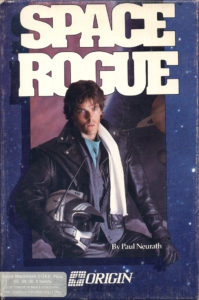
Space Rogue‘s hilarious cover art, with its artfully pouting male model who looks better suited to a Harlequin-romance cover. Paul Neurath remembers Origin’s marketing department asking him about his packaging preferences for his game. He said he would prefer a “non-representational” cover picture. Naturally, the marketers delivered about the most representational thing imaginable.
By the time of Space Rogue‘s release, Paul Neurath was a lonelier game developer than ever. In January of 1989, the last remnants of Origin’s New Hampshire operation had moved to Austin, leaving Neurath stranded in what Richard Garriott liked to call “the frozen wastes of New England.” For him, this was a crossroads of life if ever there was one. Did he want to continue to make games, and, if so, how? Sure, he could probably move down to Austin and get a job with Origin, but, truth be told, he had no more desire to live in Texas than Garriott had to live in New England. But how else could he stay in games?
At last, Neurath decided to take a page from Ned Lerner’s book. He would put together his own little company and try to establish it as an independent studio; after all, it had worked out pretty well for Ned so far. He registered his company under the name of Blue Sky Productions.
Neurath had always loved the CRPG genre, ever since Wizardry had become one of the first games he bought for his new Apple II. That love had once led him to publish Deep Space through Sir-Tech, and sent him out to Origin’s New Hampshire offices for that fateful visit. Now, he dreamed of taking the first-person dungeon crawl beyond the turn-based Wizardry, even beyond the real-time but still grid-based Dungeon Master, the state of the art in the genre as the 1980s expired. On a visit to Lerner Research, he saw the technology that he believed would make the genre’s next step possible — the foundation, one might even say, for everything he and his fabled studio Looking Glass would do in the 1990s. What he saw was the first 3D texture mapper that was suitable for use in an ordinary computer game.
3D graphics were hardly unknown on personal computers of the 1980s, as can be seen not least through the early careers of Ned Lerner and Paul Neurath. Yet, being enormously taxing to implement in the context of an interactive game, they demanded a lot of aesthetic compromise. Some early 3D games, such as Elite and the first versions of subLogic’s Flight Simulator, didn’t draw in the surfaces of their polygons at all, settling for wire frames. With the arrival of more powerful 16-bit computers in the mid-1980s, filled surfaces became more common in 3D games, but each side of a polygon was drawn in a single color. Combine this fact with the low polygon count that was still necessitated by the hardware of the time — resulting in big, fairly crude polygons — and you had a recipe for blotchy landscapes made up of garishly clashing primary colors.
A few clever developers were able to turn the limitations of 3D graphics into an aesthetic statement in its own right. But most of those who used them — among them makers of flight simulators and space shooters, such as Lerner and Neurath — suffered with their limitations because there just wasn’t any practical alternative for the sorts of games they were making. For an out-the-cockpit view from an airplane, the aesthetic compromises necessitated by going 3D were just about acceptable, given the way the distant landscape below tends to blur into hazy abstractions of color even in real life. But for a more personal, embodied experience, such as a first-person dungeon crawl, real-time 3D graphics were just too crude, too ugly. You couldn’t render the grain of a wooden door or the patina of a stone wall as one uniform splotch of color and expect to get away with it — not with the way that gamers’ audiovisual expectations were increasing every year.
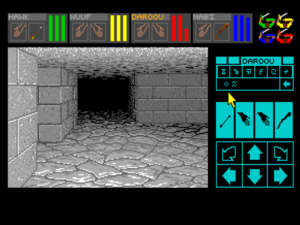
A screenshot from Dungeon Master, the state of the art in dungeon crawls at the end of the 1980s. Notice how the walls, floor, and ceiling are shown in aesthetically pleasing detail. This was possible because movement in Dungeon Master was still based on a grid, which meant that each view could be assembled from pre-rendered component parts rather than needing to be rendered from scratch. A free-scrolling, real-time-rendered 3D version would have had to replace all of this detail with great uniform slabs of gray in order to run at an acceptable speed. The result, needless to say, would not have been pretty.
None of these problems were unknown to academic computer-graphics researchers; they’d been wrestling with them since well before the first personal computer hit the market. And they’d long since come up with a solution: texture mapping. The texture in question takes the form of an ordinary image file, which might be drawn by hand or digitized from a real-world photograph. A texture suitable for a wooden door, for example, could be an extreme closeup of any slab of wood. The texture is “glued” onto a polygon’s face in lieu of a solid color. Just like that, you suddenly have doors that look like real doors, slimy dungeon walls that look like real slimy dungeon walls.
The problem with texture mapping from the perspective of game development was the same one that haunted the whole field of 3D graphics: the problem of performance. Simple though the basic concept is, a lot of tricky math comes into play when one introduces textures; figuring out how they should wrap and fit together with one another over so many irregular polygonal surfaces is much more complicated than the lay observer might initially believe. At a time when just managing to paint the sides of your polygons in solid colors while maintaining a respectable frame rate was a real achievement, texture mapping was hopeless. Maybe it could be used in another decade or so, said the conventional wisdom, when Moore’s Law put a supercomputer on every desk.
But one recent arrival at Lerner Research wasn’t so sure that texture mapping was impossible using extant PC hardware. Chris Green had considerable experience with interactive 3D graphics, having spent several years at subLogic working on products like Flight Simulator and Jet. He arrived at Lerner Research knowing that texture mapping couldn’t be done on the likes of an 8-bit Apple II, the computer on which Neurath and Lerner among so many others had gotten their start. On the latest 16- and 32-bit MS-DOS hardware, however… he suspected that, with the right compromises, he could make it work there.
There was doubtless much efficient code in the texture mapper Green created, but it was indeed an unabashed compromise that made it feasible to attempt at all. The vertices of the polygons in a 3D graphics system are defined with an X, a Y, and a Z coordinate; it’s this last, of course, that makes such a system a 3D system at all. And it’s also the Z coordinate that is the source of all of the complications relating to 3D graphics in general. Nowhere is this more true than in the case of texture mapping. To do it correctly, textures have to be scaled and transformed to account for their position in relation to the viewing location, as largely defined by their Z coordinate. But Green didn’t bother to do texture mapping correctly; he effectively threw away the Z coordinate and glued his textures onto their polygons as if they were in a 2D space. This technique would come to be known inside the industry as “affine texture mapping.” It yielded an enormous increase in rendering speed, balanced by a degree of distortion that was almost unnoticeable in some situations, very noticeable indeed in others. Still, an imperfect texture mapper, Green decided, was better than no texture mapper at all.
Ned Lerner had recently signed a contract with EA to make a driving game bearing the name of Car and Driver magazine. Knowing the technology’s limitations, he planned to use Chris Green’s texture mapper in a somewhat constrained fashion therein, to draw onto the faces of billboards and the like. Yet he wasn’t averse to sharing it with Paul Neurath, who as soon as he saw it wanted to use it to take the next step beyond Dungeon Master.
To do so, however, he’d need more programmers, not to mention artists and all the rest; if there was one thing the two years or so he had spent making Space Rogue had taught him, it was that the days of the one-man development team were just about over. Luckily, a friend of his had a nephew who had a friend who was, as Neurath would be the first to admit, a far better programmer than he would ever be.
Doug Church was an MIT undergraduate who had let himself get so consumed by the fun going on inside the university’s computer labs that it had all but derailed his official education. He and his buddies spent hours every day hacking on games and playing them. Their favorite was a 3D tank game called Xtank, written by one of their number, a fellow student named Terry Donahue. They tinkered with its code endlessly, producing variations that departed radically from the original concept, such as a Frisbee simulator. When not coding or playing, they talked about what kinds of games they would like to make, if only they had infinite amounts of money and time and no hardware limitations whatsoever. They envisioned all sorts of little simulated worlds, rendered, naturally, in photo-realistic 3D graphics. Thus when Neurath introduced himself to Church in early 1990 and asked if he’d like to work on a free-scrolling, texture-mapped 3D dungeon crawl running in real time, he dropped his classes and rushed to get in on the chance. (Terry Donahue would doubtless have been another strong candidate to become lead programmer on the project, but he felt another calling; he would go on to become a priest.)
Neurath also found himself an artist, a fellow named Doug Wike who had worked on various projects for Origin in New Hampshire before those offices had been shuttered. Together the three men put together a crude non-interactive demo in a matter of weeks, showing the “player” moving up a texture-mapped dungeon corridor and bumping into a monster at the end of it. At the beginning of June, they took the demo to the Summer Consumer Electronics Show, where, behind all of the public-facing hype, many of the games industry’s most important deals got made.
As Neurath tells the story, the response from publishers was far from overwhelming. The demo was undeniably crude, and most were highly skeptical whether this unproven new company could get from it to a real, interactive game. It turned out that the only publisher willing to give the project any serious consideration at all was none other than Neurath’s old friends from Origin.
That Neurath hadn’t taken his idea to Origin straight away was down to his awareness of a couple of strategic decisions that had recently been made there, part of a whole collection of changes that were being made to greet the new decade’s challenges. Origin had, first of all, decided to stop giving contracts to outside developers, taking all development in-house so as to have complete control over the products they released. And secondly, they had decided, for the time being anyway, to make all of their output fit into one of two big franchises, Ultima and Wing Commander. Both of these decisions would seem to exclude Blue Sky’s proposed dungeon crawler, which they were calling simply Underworld, from becoming an Origin product. Nor did it help that a sexy public demonstration of the first Wing Commander game [1]Wing Commander was actually still known as Wingleader at this time. had become the hit of the show, making it difficult for Origin to focus on anything else; they could practically smell the money they were about to make from their new franchise.
Luckily, Blue Sky and Underworld found a champion at Origin even amidst all the distractions. Warren Spector was a relatively recent arrival at the company, but Neurath knew him pretty well; as his very first task for Origin, Spector had spent about a month expanding and polishing the text in Space Rogue just before its release. Now, looking at Underworld, he was sure he saw not just a game with real commercial potential but a technologically and aesthetically important one. “I was blown away,” he says today. “I remember thinking as I watched that demo that the world had just changed.” Spector convinced his colleagues to take a chance, to violate their rule of in-house development and sign a contract with Blue Sky, giving them a modest advance of $30,000. If the game worked out, they might be in on the ground floor of something major. It might also be something they could brand with the Ultima name, make into the beginning of a whole new sub-series in the franchise — a revival of the first-person (albeit turn-based) dungeons that had been in every Ultima through Ultima V. And if it didn’t work out, the $30,000 they’d lose on the flier was far from a fortune. The deal was done.
With that mission accomplished, Neurath’s little team returned to the office space he’d rented for them in New Hampshire. They spent almost a year there trying to understand the new set of technical affordances which Chris Green’s texture mapper had put at their disposal. They didn’t invent anything fundamentally new in terms of 3D graphics technology during that time. Like the texture mapper which spawned the project, everything they put into Underworld could be found in any number of books and journals at the MIT library, many of them dating well back into the 1970s and even 1960s. It was just a matter of adapting it all to the MS-DOS architecture. As it happened, the hardware they had to work with was about equal to the cutting-edge research workstations of ten years ago, so the old journal articles they pored over actually made a pretty good fit to it.
They kept coming back to the theme of embodiment, what Neurath called “a feeling of presence beyond what other games give you.” None of the earlier dungeon crawlers — not even those in the Dungeon Master tradition that ran in real time — had been able to deliver this. They could be exciting, stressful, even terrifying, but they never gave you the feeling of being physically embodied in their environments. It was the difference between reading a book or watching a movie and really being someplace.
It went without saying that Underworld must place you in control of just one character rather than the usual party of them. You needed to be able to sense the position of “your” body and limbs in the virtual space. Neurath:
We wanted to get a feeling that you were really in this dungeon. What would you expect to do in a dungeon? You might need to jump across a narrow chasm. You might expect to batter down a wooden door. You might expect to look up if there was a precipice above you. All these sorts of physical activities. And we tried to achieve, at least to a reasonable degree, that kind of freedom of motion and freedom of action. That really extended the R&D stage. It was about nine months, even a year, before we had all the underlying technology in place that allowed us to visualize this fantasy universe in a manner that we felt was appropriate and would work well and would allow the player the freedom to maneuver around and perform different kinds of actions.
Over the course of this time, Neurath hired only one more programmer, one Jonathan “J.D.” Arnold, who had previously worked on Infocom’s Z-Machine technology in that company’s twilight years. But finally, in the late spring of 1991, with the basic interface and the basic technical architecture all in place, Neurath decided it was time to hire some more people and make a real game out of it all. Doug Church immediately thought of his old friends back at MIT, and Neurath had no objections to recruiting from that pool; they were smart and passionate and, just as importantly, they were all happy to work for peanuts. Given the time of year it was, Church’s old buddies were all either graduating or finishing up their semester of coursework, leaving them free to come to Blue Sky.
None of these people had ever worked on a commercial computer game before. In fact, most of them hadn’t even played any commercial computer games recently, having been ensconced for the last several years inside the ivory tower of MIT, where the nature of gaming was markedly different, being a culture of creation rather than strictly one of consumption. And yet, far from being a disadvantage, the team’s sheer naivete proved to be the opposite, making them oblivious to the conventional wisdom about what was possible. Doug Church:
I had actually played Space Rogue because one of my friends had a Mac, but the clusters [at MIT] were all Unix boxes so I ran X-Trek and NetHack and things, but I hadn’t played a PC game in five years or something. So we just said, “Let’s do a really cool dungeon game in 3D, let’s go.” It’s interesting because a lot of people talk about how we were doing such a Dungeon Master game, but as far as I know none of us had ever played Dungeon Master. We didn’t have any idea we were doing anything that wasn’t just obvious in some sense because we had no context and the last time any of us had played a [commercial] game was back when we were fourteen. We played games in college, but they were very different; you’re playing networked X-Trek or something, it doesn’t feel like a home-computer game.
At first, the new arrivals all crowded into the New Hampshire office Neurath was renting. But most of them were actually living together in a rambling old three-story house in Cambridge, Massachusetts, and it struck them as silly to make the drive out to New Hampshire every day. They soon convinced Neurath to let them work on the game from home. From dawn until night, seven days a week, they ate, drank, slept, and breathed Underworld there.
At a time when most studios had begun to systematize the process of game development, dividing their employees into rigid tiers of specialists — programmers, artists, designers, writers — Blue Sky made a virtue of their complete lack of formal organization. It was an org-chart-wielding middle manager’s nightmare; just about everybody wound up doing a little bit of everything. There was nothing like a designer giving instructions to a technical team. Instead, Blue Sky’s method of working was more akin to the way that things got done among the hackers at MIT — a crowd of equals pulling together (and occasionally pulling apart) to work toward a common goal. Anyone could contribute absolutely anywhere, knowing his ideas would be judged only on their intrinsic worth.
When it became clear that it was time to start making the actual dungeon the Underworld player would have to explore, the team divided up this design work in the most democratic manner imaginable: everybody made one level, then they were all combined together to make the eight-level final dungeon. Dan Schmidt, who had officially been hired for the role of “AI programmer,” agreed to take on the mantle of “writer,” which really meant coordinating with everyone to merge the levels into a seamless whole.
For most of the time the game was in development, Origin’s role and overall interest — or, rather, lack thereof — was a consistent sore spot. It often seemed to Blue Sky that the folks in Austin had entirely forgotten their existence way off in the frozen wastes of New England. This was good in the sense that they got to make exactly the game they wanted to make, but it didn’t do much for their confidence that a committed publisher would be ready and eager to market it properly when they were done. Warren Spector was busy with Wing Commander and, later, with an Ultima spinoff called Martian Dreams, so Origin initially assigned Jeff Johannigman to Blue Sky in the role of producer. Communication with him was nothing short of terrible. After going two full months without hearing a peep from him, Neurath tried to call him down in Austin, only to be told that he had left the company. A second producer was finally selected, but he wasn’t much more engaged. Blue Sky believed they were making a great, groundbreaking game, but it seemed that Origin really couldn’t care less.
In many ways, Underworld was at odds with the prevailing trends inside Origin, not to mention in much of the games industry at large. Following the huge success of the first Wing Commander, Origin was banking heavily on cinematic games with big, set-piece storylines. The company’s org chart reflected the new impetus, with film-making terminology — producer, director, screenwriter — shoehorned in absolutely everywhere. Blue Sky, on the other hand, was making something very different, an immersive, emergent, non-linear experience without cut scenes or chapter breaks. Yes, there was a plot of sorts — the player got cast into a dungeon to rescue a princess or die trying — along with puzzles to be solved, quests to be fulfilled, and other characters to be spoken to, but it was all driven by the player, not by any relentlessly unspooling Hollywood-style script. Origin, it seemed, wasn’t quite sure what to make of it, wasn’t quite sure where it fit. And certainly it’s easy enough, given Blue Sky’s unorthodox working methods, to understand why so many at Origin were skeptical of their ability to deliver a finished game at all.
The danger of Blue Sky’s approach was that they would keep iterating endlessly as they kept having better and better ideas. This tendency among hackers to never be able to finish something and walk away from it had already derailed more than one promising games studio — not least among them FTL, the makers of the storied Dungeon Master, who had yet to release a proper followup after some four years. (Dungeon Master II wouldn’t finally arrive until 1995.) The need to finish games on a timetable was, one might say, the reason that industry executives had begun to impose the very organizational structures that Blue Sky was now so happily eschewing. Doug Church remembers creating “four movement systems and three combat systems because we’d just write something: ‘Oh, this seems cool, go for it.'” Would they just continue chasing whatever shiny objects struck their fancy until the money ran out? That wouldn’t take much longer, given that Paul Neurath was largely financing the whole effort out of his pocket, with some help from his ever-loyal friend Ned Lerner, whose success with his Chuck Yeager flight simulators had left him with a bit of money to spare.
Thus they were all fortunate that Warren Spector, their once and future savior, suddenly returned on the scene late in 1991. Virtually alone among his colleagues down in Austin, Spector had been watching Blue Sky’s progress with intense interest. Now, having finished up Martian Dreams, he got himself assigned as Underworld‘s third producer. He had considerable clout inside the bigger company; as soon as he started to press the issue there, things started to happen on Origin’s side to reassure Blue Sky that their game would in fact be released if they could only deliver it.
Indeed, after almost eighteen months of uncertainty on the question, Origin finally made it official that, yes, Underworld would be released as an Ultima game. As usual, the star would be the Avatar, who was becoming quite a busy fellow between this game, the mainline Ultima games, and the recent pair of Worlds of Ultima spinoffs. The dungeon in question, meanwhile, would be none other than the Stygian Abyss, where the Avatar had found the Codex of Ultimate Wisdom at the end of Ultima IV. Underworld‘s backstory would need to be bent and hammered enough to make this possible.
Blue Sky soon discovered that becoming an official Ultima game, while great for marketing purposes and for their own sense of legitimacy, was something of a double-edged sword. Origin demanded that they go back through all the text in the game to insert Ultima‘s trademark (and flagrantly misused) “thees” and “thous,” provoking much annoyance and mockery. And Origin themselves made a cinematic introduction for the game in Austin, featuring Richard Garriott, one of the industry’s worst voice actors of all time — and that, friends, is really saying something — in the leading role, bizarrely mispronouncing the word “Stygian.” It seems no one at Origin, much less at Blue Sky, dared to correct Lord British’s diction… (The British magazine PC Review‘s eventual reaction to the finished product is one for the ages: “I had to listen to it two or three times before I fully grasped what was going on because for the first couple of times I was falling about laughing at the badly dubbed Dick Van Dyke cockney accents that all these lovable Americans think we sound like. You know: ‘Awlright, Guv’noor, oop the happle un stairs!'”)
While Origin made the dodgy intro in Texas, Warren Spector got everybody in New England focused on the goal of a finished, shipped game. Doug Church:
Not only was he [Spector] great creatively to help us put finishing touches on it and clean it up and make it real, but he also knew how to finish projects and keep us motivated and on track. He had that ability to say, “Guys, guys, you’re focused in totally the wrong place.” He had that ability to help me and the rest of the guys reset, from the big-picture view of someone who has done it before and was really creative, but who also understood getting games done. It was a huge, huge win.
It’s very easy in hacker-driven game development to wind up with a sophisticated simulation that’s lots of fun for the programmers to create but less fun to actually play. Spector was there to head off this tendency as well at Blue Sky, as when he pared down an absurdly complex combat system to something simple and intuitive, or when he convinced the boys not to damage the player’s character every time he accidentally bumped into a wall. That, said Spector, “doesn’t sound like fun to me” as a player — and it was the player’s fun, he gently taught Blue Sky, that had to be the final arbitrator.
At Spector’s behest, Neurath rented a second office near Boston — officially known as the “Finish Underworld Now” office — and insisted that everyone leave the house and come in to work there every day during the last two months of the project. The more businesslike atmosphere helped them all focus on getting to the end result, as did Spector himself, who spent pretty much all of those last two months in the office with the team.
Spector did much to make Blue Sky feel like a valued part of the Origin family, but the relationship still remained rocky at times — especially when the former learned that the latter intended to release Ultima Underworld just two weeks before Ultima VII, the long-awaited next title in the franchise’s main series. It seemed all but certain that their game would get buried under the hype for Ultima VII, would be utterly forgotten by Origin’s marketers. Certainly marketing’s initial feedback hadn’t been encouraging. They were, they said, having trouble figuring out how to advertise Ultima Underworld. Its graphics were spectacular when seen in motion, but in still screenshots they didn’t look like much at all compared to a Wing Commander II or an Ultima VII. Blue Sky seethed with frustration, certain this was just an excuse for an anemic, disinterested advertising campaign.
In Origin’s defense, the problem their marketers pointed to was a real one. And it wasn’t really clear what they could have done about the release-date issue either. The original plan had been, as they didn’t hesitate to remind Blue Sky, to release Ultima Underworld in time for the Christmas of 1991, but the protracted development had put paid to that idea. Now, Blue Sky themselves needed Ultima Underworld to come out as quickly as possible because they needed the royalties in order to survive; for them, delaying it was simply impossible. Meanwhile Origin, who had cash-flow concerns of their own, certainly wasn’t going to delay Ultima VII, quite possibly the most expensive computer game ever made to that point, for a mere spinoff title. The situation was what it was.
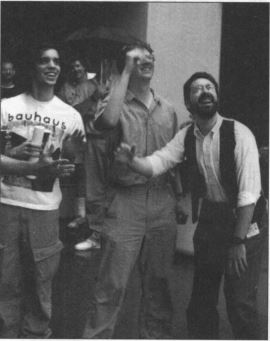
The balloons fly as Doug Church, Paul Neurath, and Warren Spector celebrate Ultima Underworld‘s release.
Whatever was to happen in terms of sales, Blue Sky’s young hackers did get the satisfaction in late March of 1992 of seeing their game as a boxed product on store shelves, something more than one of them has described as a downright surreal experience. Dan Schmidt:
We were a bunch of kids straight out of school. This was the first professional project we’d ever done. We felt lucky that anyone would see it at all. We’d go into a games store and see our game there on the shelf. Someone would walk up to it, and we’d want to say, “No! No! You don’t want to buy that! We just hacked that together. It’s not, like, a real game.”
In the beginning, sales went about as expected. A snapshot from Origin’s in-house newsletter dated July 31, 1992, shows 71,000 copies of Ultima VII shipped, just 41,000 copies of Ultima Underworld. But, thanks to ecstatic reviews and strong word of mouth — Origin may have struggled to see how groundbreaking the game really was, but gamers got it immediately — Ultima Underworld kept on selling, getting stronger every month. “It was the first game that ever gave me a sense of actually being in a real place,” wrote one buyer in a letter to Origin, clear evidence that Blue Sky had absolutely nailed their original design goal. Soon industry scuttlebutt had it outselling Ultima VII by two to one. Paul Neurath claims that Ultima Underworld eventually sold more than half a million copies worldwide, an extraordinary figure for the time, and considerably more than Ultima VII or, indeed, any previous Ultima had managed.
Shortly after Ultima Underworld‘s release, Paul Neurath and Ned Lerner finally did the obvious: they merged their two companies. They had recently discovered that another, slightly older company was already operating under the name of “Blue Sky Software,” making educational products. So, they named the merged entity Looking Glass Technologies. Their first release under the name would be Ultima Underworld II.
Two months after the first Ultima Underworld appeared, a tiny company out of Dallas, Texas, who called themselves id Software released Wolfenstein 3D, another first-person game set in a 3D environment. Their game, however, had none of the complexity of Ultima Underworld, with its quests and puzzles and magic spells and its character to develop and even feed. In id’s game, you ran through the environment and killed things — period.
For the remainder of the 1990s, 3D games would exist on a continuum between the cool, high-concept innovation of Looking Glass and the hot, visceral action of id, who were interested in innovation in the area of their graphics technology but somewhat less so in terms of their basic gameplay template. id would win the argument in terms of sales, but Looking Glass would make some of the most fascinating and forward-looking games of the decade. “We were thinking, ‘Why don’t we just run around and shoot?’” says Austin Grossman, another early Looking Glass employee. “But we were interested in simulation and depth. We were driven by this holy grail of simulated worlds, by that enabled choice and creativity of the player.”
We’ll be following the two companies’ artistic dialog for a long time to come as we continue with this history. First, though, we need to give Ultima Underworld a closer look, from the perspective of the player this time, to understand why it’s not just an example of groundbreaking technology but a superb example of pure game design as well.
(Sources: the books Game Design: Theory & Practice 2nd edition by Richard Rouse III, Ultima VII and Underworld: More Avatar Adventures by Caroline Spector, Dungeons and Dreamers: The Rise of Computer Game Culture from Geek to Chic by Brad King and John Borland, and Principles of Three-Dimensional Computer Animation: Modeling, Rendering, and Animating with 3D Computer Graphics by Michael O’Rourke; Questbusters of February 1992 and September 1992; PC Review of June 1992; Game Developer of April/May 1995, June/July 1995, August/September 1995, December 1995/January 1996, and April/May 1996; Commodore Magazine of January 1988; Origin’s internal newsletter Point of Origin from January 17 1992, March 27 1992, May 8 1992, August 28 1992, and December 18 1992. Online sources include “Ahead of Its Time: A History of Looking Glass” on Polygon, an interview with Paul Neurath and Doug Church on the old Ultima Online site, Gambit Game Lab’s interviews with Paul Neurath and Dan Schmidt, and Matt Barton’s interview with Paul Neurath. My thanks to Dan Schmidt and Ned Lerner for making the time to talk with me personally about their careers.
Ultima Underworld and its sequel can be purchased from GOG.com.)
Footnotes
| ↑1 | Wing Commander was actually still known as Wingleader at this time. |
|---|

